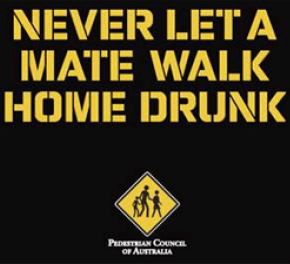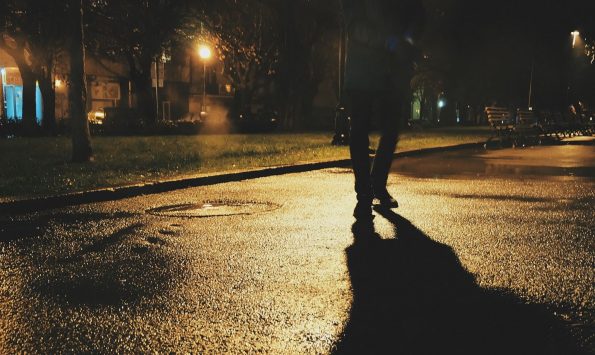Drink walking is when a person is drunk and walks home. It’s very common among young males aged 18-30 and one-third of all pedestrian fatalities are people who have a blood alcohol level above the legal driving limit of 0.05 (with many of them having a level above 0.15.)

Pedestrian Council of Australia’s campaign ‘Never let a mate walk home drunk’
Campaigns such as ‘Safe Night Out’ and projects such as ‘Drink Safe Walk Safe’, designated driver programmes and an improved availability of public transport and ride sharing services (e.g. Uber) have helped, but it’s still a problem.
Some countermeasures have been tried such as lowering vehicle speeds around licenced venues and including pedestrian fencing to prevent walkers going straight out on the road. Lock out policies, where bars won’t let you in if you’re already drunk, and responsible alcohol serving policies have the effect of reducing the overall drunkenness.
When drink walkers also use a cellphone, the risk of being run over by a moving vehicle is dramatically increased.
Drink walkers have been fined in the past.
Drugged walking – similar, but different
While alcohol has a predictable effect on walker’s, different drugs can have different types of effects as some drugs will cause lethargy and slow reactions while others will cause hypersensitivity.
How to drive around drink walkers?
Drink walkers can stumble into the road at any time. When you’re driving around areas with a lot of licenced premises, keep your speed down and watch out for drunk people on pavements or looking like they’re going to cross the road. Drunk walkers will have slower reaction times and won’t be able to move as quickly. They won’t be able to judge the speed and trajectory of your vehicle, and their hearing could be impaired for two reasons: alcohol intake reduces our hearing, and loud nightclubs and bars do, too.

Pedestrians are very difficult to see at night, even if they’re on the road in front of you
Drink walkers are likely to walk on the road in unlit streets without realising the danger, usually wearing non-reflective clothing that makes them harder to see. Sometimes they fall asleep in the road.
